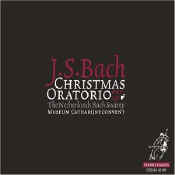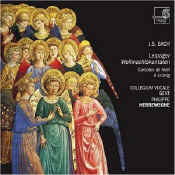|
You are reading the older HTML site Positive Feedback ISSUE 10october/november 2003
Merry Christmas from J.S. Bach, Harmonia Mundi and Channel Classics
J.S. Bach, Christmas Oratorio The secular origin of the music of four of the six cantatas that make up Bach's Christmas Oratorio has always figured prominently in writing about it. For the general listener it needn't be a concern, but it is interesting to know that the first three of the six were written to celebrate two royal birthdays and the anniversary of an accession to power—all for the princely house of Saxony; and that Bach valued the music too highly not to make something more splendid and generally useful of it. He built them into a new, sacred context, an oratorio of six thematically connected cantatas celebrating the Christmas season from Christmas Day to Ephiphany. The three earlier cantatas supply all of the arias for the first four in the Oratorio. He wrote a new piece (Number 5), and then inserted another earlier Christmas cantata as Number 6, whose original has been lost. All of the texts are new. The music itself hints of its origins only in that it is a good deal more energetic and dance-like that we generally associate with sacred occasions, which to my ears is all to the good! I enjoyed all and loved some of this music for years as I heard it during many holiday seasons with no knowledge of its origin. What has always drawn me to the Oratorio is its lyricism and sense of flow, qualities brought out effectively in this new, sumptuously packaged, CD/SACD hybrid version by the Netherlands Bach Society. Baroque fans who prefer their Bach bold, quick-paced, and contrasty may find this version, led by the group's principal conductor, Jos van Veldhoven, too much at peace with the music and its occasion. Ton Koopman in his 1996 version on ERATO takes much the same approach (and also in his Compete Bach Cantatas series, which has been revived and is being continued by Challenge Classics). Philip Herreweghe (Virgin Classics, 1989) and his soloists bring a bit more brio and virtuosity to the music; and the use of male alto Michael Chance where Veldhoven and Koopman use a woman, brings a slightly tangier quality to the music. The richer alto voice of Annette Markert is definitely in keeping with the overall mood of Veldhoven's production. Textures are a bit clearer with Herreweghe, vocal and instrumental soloists stronger, all of which makes for a more brilliant performance. But brilliance isn't the only way to Bach, and a lot can be said for the warm, richer sounding, less brilliant approach of the Netherlands group. And I found myself perfectly happy with the lesser known soloists overall. I always judge performances of the Christmas Oratorio by Cantata Number 5, the one that justifiably stands out for most listeners as the highlight of the work. Veldhoven's #5 is notable for its sense of coherence—orchestra and chorus are often almost one voice. It is this characteristic that can stand for the whole performance, where throughout we find we are listening to the Netherlands Bach Society rather than to its individual voices. The truth is, you have to search through the album booklet to find out who the performers are, including the director! In Herreweghe's Cantata Number 5, as I suggested above, we are more aware of the individual voices; and the chorus and orchestra, while wonderfully in concert, are clearly distinct contributors. Koopman in this cantata strikes a middle course, though he is closer to Herreweghe—and to be fair, since all three performances are led by northern European conductors and performed primarily by northern European musicians, they are a good deal more alike than different. Herreweghe's forces do include more of an international cast, however. Something should definitely be said here about the extraordinary packaging Channel Classics has provided for this album. The handsome, clothbound booklet in addition to succinct and useful commentary and text, provides a generous collection of full-color photographs of fifteenth and sixteenth century nativity scenes—paintings, sculptures, and illuminations from manuscripts, turning the whole package into an impressive gift, as was doubtless intended. I understand we are to expect something similar for the Easter holiday season. Sound is, as we should expect from Jared Sacks, superb. I auditioned the album in CD and will return to it when I audition and review two SACD players later this winter.
JS Bach, Leipzig Christmas Cantatas Speaking of Herreweghe, also new for the 2003-2004 holiday season is a two CD album of several other Christmas cantatas by Bach and the original version of the Magnificat. The Magnificat was written as a Christmas celebratory piece in 1723 with four movements included that announce the advent of Christ's birth and subsequently the birth itself. Bach subsequently removed these movements from the piece to make its performance on other occasions more suitable, and the shortened version is the one most of us know. It is nice to hear the work as originally written, and the four brief sections add something valuable if not extraordinary to the work. Herreweghe's Bach is fairly consistent in approach. As in the Oratorio, there is great clarity of voices, vocal and instrumental; also a wonderful sense of energy (or spirit if you prefer) that is partly the product of a brisk but unhurried pace. Also, appropriate for celebratory music, he provides generous performing forces of near virtuosic caliber. Herreweghe has been inexplicably (to me) considered a more spiritual (as distinct from spirited) than lively interpreter of Bach. That view is trotted out again in the current Gramophone review of this album by Jonathan Freeman-Atwood. I found his remark that Koopman is more "infectious" than Herreweghe on this music a stopper and had to pull out my Koopman (#63 and #91) to check. Ah, just as I thought. I am as big a fan of Koopman as anyone, am collecting his complete Bach series and find his Mozart serenades and symphonies among the very best. But Ton Koopman's Bach, especially BWV 63 and 91, compared with Herreweghe's, are not infectious. They are traditional, straightforward, slightly reserved Bach, and I like them for that. If you don't like infectious Bach, Koopman's your man. I don't believe in definitive Bach, there are too many different ways to make the master sing; but if I had to choose just one interpreter, it would probably be Herreweghe, who expresses joyous belief rather than awed reverence, which, if you know much about Bach's life, is probably the preferred approach! Once again, wonderful sound, which Herreweghe's approach shows off to great effect.
|


